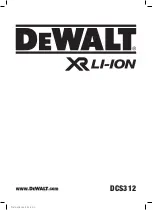
PTS 710 A2
■
6
│
GB
│
IE
g)
Always use saw blades of the correct size
and with an appropriate central attachment
hole (e.g. star-shaped or round).
Blades that
do not match the mounting hardware of the saw
will run eccentrically, causing loss of control.
h)
Never use damaged or incorrect blade
washers or bolts.
The saw blade washers and
screws have been specially designed for your
saw to provide optimum performance and
operational safety.
Further safety instructions for
all saws
Kickback – causes and corresponding
safety tips
–
A kickback is a sudden reaction caused as a
result of the saw blade catching, jamming or
being falsely aligned that cause the saw to
jump up uncontrollably and out of the work-
piece in the direction of the operator;
–
if the saw blade catches or jams in a narrowing
saw cut, the blade can no longer rotate and the
power of the motor throws the appliance back
in the direction of the operator;
–
if the saw blade twists in the saw cut or
becomes misaligned, the teeth at the rear edge
of the saw blade can become caught in the
surface of the workpiece, causing the saw
blade to jump out of the cut and the saw to
jump backwards in the direction of the operator.
Kickback is a result of saw misuse and/or incorrect
operating procedures or conditions. This can be
avoided by taking proper precautions as given
below.
a)
Hold the saw firmly in both hands and position
your arms such that they can absorb the force
of a kickback. Always stand to the side of the
saw blade and never in line with it.
If a kick-
back occurs, the circular saw may jump back-
wards. However, the operator can control the
kickback forces by taking appropriate precau-
tions.
b)
If the saw blade jams or you stop working,
switch the saw off and hold it steadily in the
workpiece until the saw blade has completely
stopped turning. Never attempt to remove the
saw from the workpiece or pull it backwards
while the saw blade is still moving as this could
lead to a kickback.
Investigate and take correc-
tive actions to eliminate the cause of the jam.
c)
If you want to restart a saw that is still in the
workpiece, centre the saw blade in the cut
and check to ensure that the teeth are not
caught anywhere in the workpiece.
If the saw
blade catches, it can jump out of the workpiece
or cause a kickback when the saw is restarted.
d)
Support large panels to minimise the risk of
the blade jamming and kickback.
Large panels
tend to bend under their own weight. Panels
must be supported on both sides, in the vicinity
of the saw cut and also at the edge.
e)
Do not use blunt or damaged saw blades.
Saw blades with blunt or misaligned teeth may
cause excessive friction if the saw cut is too
narrow, and this can cause a saw blade jam
and kickback.
f)
Before sawing, ensure that the fastenings for
the cut depth and cut angle settings are tight-
ened.
If the settings change while sawing, the
saw blade might jam and cause a kickback.
g)
Be particularly careful when sawing in
existing walls or other obscured areas.
The
inserted saw blade could get caught on hidden
objects and cause a kickback.
Specific safety instructions
for this saw
Function of the blade guard
a)
Before every use, check to ensure that the
blade guard closes properly. Do not use the
saw if the blade guard does not move freely
and does not close immediately. Never jam
or fasten the blade guard; this would leave
the saw blade unprotected.
If the saw is acci-
dentally dropped, the blade guard may be
bent. Ensure that the blade guard moves freely
and does not touch the saw blade or other
parts at any cutting angles or depths.
Summary of Contents for PTS 710 A2
Page 21: ...PTS 710 A2 18 GB IE...










































